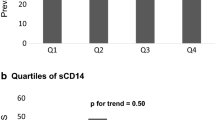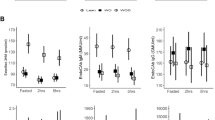Abstract
Emerging data indicate that gut-derived endotoxin (metabolic endotoxemia) may contribute to low-grade systemic inflammation in insulin-resistant states. Specific gut bacteria seem to serve as lipopolysaccharide (LPS) sources and several reports claim a role for increased intestinal permeability in the genesis of metabolic disorders. Therefore, we investigated the serum levels of LPS and zonulin (ZO-1, a marker of gut permeability) along with systemic levels of tumor necrosis factor-α (TNF-α) and Interleukin-6 (IL-6) in patients with type 2 diabetes mellitus (T2DM) compared to control subjects. Study subjects were recruited from the Chennai Urban Rural Epidemiology Study [CURES], Chennai, India. Study group (n = 45 each) comprised of a) subjects with normal glucose tolerance (NGT) and (b) patients with T2DM. LPS, ZO-1, TNF-α, and IL-6 levels were measured by ELISA. Serum levels of LPS [p < 0.05], LPS activity [p < 0.001], ZO-1 [p < 0.001], TNFα [p < 0.001], and IL-6 [p < 0.001] were significantly increased in patients with T2DM compared to control subjects. Pearson correlation analysis revealed that LPS activity was significantly and positively correlated with ZO-1, fasting plasma glucose, 2 h post glucose, HbA1c, serum triglycerides, TNF-α, IL-6, and negatively correlated with HDL cholesterol. Regression analysis showed that increased LPS levels were significantly associated with type 2 diabetes [odds ratio (OR) 13.43, 95 % CI 1.998–18.9; p = 0.003]. In Asian Indians who are considered highly insulin resistant, the circulatory LPS levels, LPS activity, and ZO-1 were significantly increased in patients with type 2 diabetes and showed positive correlation with inflammatory markers and poor glycemic/lipid control.





Similar content being viewed by others
Abbreviations
- T2DM:
-
Type 2 diabetes mellitus
- NGT:
-
Normal glucose tolerance
- ZO-1:
-
Zonulin-1
- LPS:
-
Lipopolysaccharide
- TNF-α:
-
Tumor necrosis factor-α
- IL-6:
-
Interleukin-6
- CURES:
-
Chennai Urban Rural Epidemiology Study
- OR:
-
Odds ratio
- OGTT:
-
Oral glucose tolerance test
- BMI:
-
Body mass index
- HbA1c:
-
Glycated hemoglobin
- LAL:
-
Limulus amebocyte lysate
- ELISA:
-
Enzyme linked immunosorbent assay
- TLR4:
-
Toll-like receptor-4
- HDL:
-
High density lipoprotein
References
Pradhan JE, Manson N, Rifai JE et al (2001) C-reactive protein, interleukin 6, and risk of developing type 2 diabetes mellitus. JAMA 286:327–334
Vozarova C, Weyer RS, Lindsay RE et al (2002) High white blood cell count is associated with a worsening of insulin sensitivity and predicts the development of type 2 diabetes. Diabetes 51:455–460
Devaraj S, Dasu MR, Jialal I (2010) Diabetes is a proinflammatory state: a translational perspective. Endocrinol Metab 5:19–28
Donath MY, Shoelson SE (2011) Type 2 diabetes as an inflammatory disease. Nat Rev Immunol 11:98–107
Hotamisligil GS (2001) Inflammation and metabolic disorders. Nature 444:860–867
Gokulakrishnan K, Mohanavalli KT, Monickaraj F et al (2009) Subclinical inflammation/oxidation as revealed by altered gene expression profiles in subjects with impaired glucose tolerance and type 2 diabetes patients. Mol Cell Biochem 324:173–181
Balasubramanyam M, Aravind S, Gokulakrishnan K et al (2011) Impaired miR-146a expression links subclinical inflammation and insulin resistance in type 2 diabetes. Mol Cell Biochem 351:197–205
Cani PD, Bibiloni R, Knauf C et al (2008) Changes in gut microbiota control metabolic endotoxemia-induced inflammation in high-fat diet-induced obesity and diabetes in mice. Diabetes 57:1470–1481
Creely SJ, McTernan PG, Kusminski CM (2007) Lipopolysaccharide activates an innateimmune system response in humanadipose tissue in obesity and type 2 diabetes. Am J Physiol Endocrinol Metab 292:E740–E747
Sapone A, de Magistris L, Pietzak M et al (2006) Zonulin upregulation is associated with increased gut permeability in subjects with type 1 diabetes and their relatives. Diabetes 55:1443–1449
Pradeepa R, Deepa R, Mohan V (2002) Epidemiology of diabetes in India—current perspective and future projections. J Indian Med Assoc 100:144–147
Alberti KG, Zimmet PZ (1998) Definition, diagnosis and classification of diabetes mellitus and its complications. Part 1: diagnosis and classification of diabetes mellitus, provisional report of a WHO consultation. Diabet Med 15:539–553
Wendel M, Paul R, Heller AR (2007) Lipoproteins in inflammation and sepsis II. Clinical aspects. Intensive Care Med 33:25–35
Pajkrt D, Doran JE, Koster F et al (1996) Antiinflammatory effects of reconstituted high-density lipoprotein during human endotoxemia. J Exp Med 184:1601–1608
Birjmohun RS, van Leuven SI, Levels JH et al (2007) High-density lipoprotein attenuates inflammation and coagulation response on endotoxin challenge in humans. Arter Thromb Vasc Biol 27:1153–1158
Joshi SR (2012) Type 2 diabetes in Asian Indians. Clin Lab Med 32:207–216
Pussinen PJ, Tuomisto K, Jousilahti P et al (2007) Endotoxemia, immune response to periodontal pathogens, and systemic inflammation associate with incident cardiovascular disease events. Arter Thromb Vasc Biol 27:1433–1439
Pussinen PJ, Havulinna AS, Lehto M et al (2011) Endotoxemia is associated with an increased risk of incident diabetes. Diabetes Care 34:392–397
Feingold KR, Staprans I, Memon RA et al (1992) Endotoxin rapidly induces changes in lipid metabolism that produce hypertriglyceridemia: low doses stimulate hepatic triglyceride production while high doses inhibit clearance. J Lipid Res 33:1765–1776
Lassenius MI, Pietiläinen KH, Kaartinen K, FinnDiane Study Group et al (2011) Bacterial endotoxin activity in human serum is associated with dyslipidemia, insulin resistance, obesity, and chronic inflammation. Diabetes Care 34:1809–1815
Nymark M, Pussinen PJ, Tuomainen AM, FinnDiane Study Group et al (2009) Serum lipopolysaccharide activity is associated with the progression of kidney disease in Finnish patients with type 1 diabetes. Diabetes Care 32:1689–1693
Buhl M, Bosnjak E, Vendelbo MH et al (2013) Direct effects of locally administered lipopolysaccharide on glucose, lipid, and protein metabolism in the placebo-controlled, bilaterally infused human leg. J Clin Endocrinol Metab 98:2090–2099
Erridge C, Attina T, Spickett CM et al (2007) A high-fat meal induces low-grade endotoxemia: evidence of a novel mechanism of postprandial inflammation. Am J Clin Nutr 86:1286–1292
Cani PD, Amar J, Iglesias MA et al (2007) Metabolic endotoxemia initiates obesity and insulin resistance. Diabetes 56:1761–1772
Sun L, Yu Z, Ye X et al (2010) A marker of endotoxemia is associated with obesity and related metabolic disorders in apparently healthy Chinese. Diabetes Care 33:1925–1932
Lira FS, Rosa JC, Pimentel GD et al (2010) Endotoxin levels correlate positively with a sedentary lifestyle and negatively with highly trained subjects. Lipids Health Dis 9:82
Oliveira Alexandre G, Bruno M et al (2011) Physical Exercise reduces circulating lipopolysaccharide and TLR4 activation and improves insulin signaling in tissues of DIO rats. Diabetes 60:784–796
Trøseid M, Nestvold TK, Rudi K et al (2013) Plasma lipopolysaccharide is closely associated with glycemic control and abdominal obesity: evidence from bariatric surgery. Diabetes Care 36(11):3627–3632
Wang W, Uzzau S, Goldblum SE et al (2001) Human zonulin, a potential modulator of intestinal tight junctions. J Cell Sci 113:4425–4440
Watts T, Berti I, Sapone A et al (2005) Role of intestinal tight junction modulator zonulin in the pathogenesis of type 1 diabetes in BB diabetic prone rats. Proc Natl Acad Sci USA 102:2916–2921
Moreno-Navarrete JM, Sabater M, Ortega F et al (2012) Circulating zonulin, a marker of intestinal permeability, is increased in association with obesity-associated insulin resistance. PLoS One 7:e37160
Backhed F, Ley RE, Sonnenburg JL et al (2005) Host-bacterial mutualism in the human intestine. Science 307:1915–1920
de La Serre CB, Ellis CL, Lee J et al (2010) Propensity to high-fat diet- induced obesity in rats is associated with changes in the gut microbiota and gut inflammation. Am J Physiol Gastrointest Liver Physiol 299:G440–G448
Larsen N et al (2010) Gut microbiota in human adults with type 2 diabetes differs from non-diabetic adults. PLoS One 5:e9085
Qin J, Li Y, Cai Z et al (2012) A metagenome-wide association study of gut microbiota in type 2 diabetes. Nature 490:55–60
Manco M, Putignani L, Bottazzo GF (2010) Gut microbiota, lipopolysaccharides, and innate immunity in the pathogenesis of obesity and cardiovascular risk. Endocr Rev 31:817–844
Amar J, Chabo C, Waget A et al (2011) Intestinal mucosal adherence and translocation of commensal bacteria at the early onset of type 2 diabetes: molecular mechanisms and probiotic treatment. EMBO Mol Med 3:559–572
Fei N, Zhao L (2013) An opportunistic pathogen isolated from the gut of an obese human causes obesity in germfree mice. ISME J 7:880–884
Acknowledgments
Authors acknowledge the financial support from the Department of Biotechnology (DBT), Government of India. Authors also acknowledge and thank the scientific inputs on clinical immunology aspects by Dr. R. B. Naryananan, Centre for Biotechnology, Anna University.
Conflict of interest
None.
Author information
Authors and Affiliations
Corresponding author
Rights and permissions
About this article
Cite this article
Jayashree, B., Bibin, Y.S., Prabhu, D. et al. Increased circulatory levels of lipopolysaccharide (LPS) and zonulin signify novel biomarkers of proinflammation in patients with type 2 diabetes. Mol Cell Biochem 388, 203–210 (2014). https://doi.org/10.1007/s11010-013-1911-4
Received:
Accepted:
Published:
Issue Date:
DOI: https://doi.org/10.1007/s11010-013-1911-4




